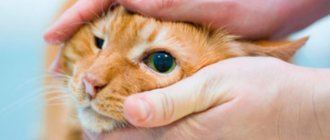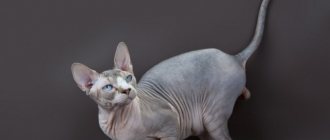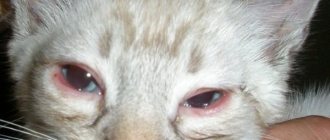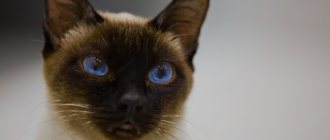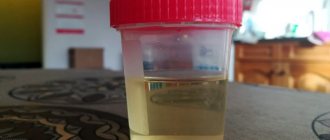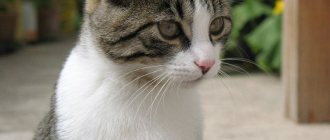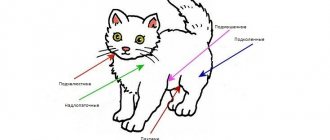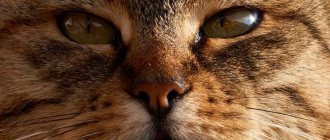Cat owners often notice purulent discharge from the eyes of their pets. Cat eyes are a vulnerable organ, and eye diseases in cats are common. If action is not taken in time, a small problem can result in loss of vision. How to determine why a cat’s eyes are festering, whether you can help your pet yourself and how to treat the discharge - more on this below.
Main symptoms of eye disease in cats
In healthy cats, a small amount of translucent discharge, sometimes brown or grayish, occasionally forms in the eyes. Such rare and isolated tearing should not cause cause for alarm in the owner. But if the discharge becomes profuse, purulent, observed daily, the eye festers with blood, the owner needs to worry and understand that the cat needs help. The disease will not disappear on its own, so such signs cannot be ignored.
Serious problems with the organs of vision are indicated by various alarming symptoms, in addition to discharge from the eyes. The owner must be alert to the following external signs and behavior of the pet:
- eyes become red or cloudy and swollen;
- the cornea becomes covered with a white film or a cataract appears;
- the cat constantly rubs his eyelids with his paw;
- often blinks constantly;
- the fur around sore eyes becomes brown and matted;
- a sticky brown crust of pus appears on the eyes, preventing the eye from fully opening;
- strabismus: often observed in early glaucoma;
- photophobia and increased sensitivity to light;
- pain: the pet begins to meow and howl when it touches its eyelids with its paw;
- aggressiveness, desire to hide in the dark, avoidance of contacts;
- loss of appetite;
- sometimes increased body temperature.
The most alarming symptoms to pay attention to are lack of appetite and increased body temperature. Prolonged persistent fever and lethargy are characteristic of viral and acute infectious diseases. This may additionally be indicated by vomiting and intestinal upset. If your cat has snot running and eyes that are purulent, it is quite possible that the animal has a runny nose. In this case, you need to pay attention to the nature of the discharge: clear snot indicates that the disease will soon pass, and yellow-green purulent discharge from the nose should cause alarm and become a reason to contact a veterinarian.
The kitten's eyes are festering - what should I wash it with?
To wipe the eyes, you can use not only decoctions of medicinal herbs, but also pharmaceutical preparations, which are widely used in surgery and in the treatment of wounds of various origins.
The kitten's eyes are festering, what to wash with:
- Furacilin solution. To prepare the product, you need to dissolve two tablets in 250 ml of hot water and heat almost to a boil, with constant stirring. It is necessary that the tablets dissolve completely. Cool the product to room temperature, soak a cotton pad in it, and wipe the cat’s eyes.
- Potassium permanganate solution. Please note that the liquid should be slightly pink, meaning the solution should be weak. Under no circumstances should a strong solution be used, as it can cause burns to the mucous membrane. A couple of crystals per glass of warm boiled water is enough. In the same way, you need to soak a cotton pad in the resulting solution and wipe your eyes.
- To treat the eyes, you can use ready-made solutions. Among them are Chlorhexidine, Miramistin, Decasan . These solutions are created without the use of alcohol, so they do not cause burns to the mucous membranes or discomfort during treatment. Ready-made products can be purchased at the pharmacy. Choose a solution that is suitable for treating mucous membranes. For example, for Chlorhexidine this is a 0.05% solution. It is necessary to soak a piece of gauze with the product and wipe the kitten’s eyelids from the outer corner of the eye to the inner one. Treatment with such antiseptics is carried out 3 times a day. This removes suppuration and also reduces the kitten's anxiety. After all, suppuration and dry crusts cause discomfort and unpleasant sensations in the animal, so the cat can additionally infect the wound.
Rest
Causes of suppuration and tearing
Purulent discharge from the eyes of cats can be caused by various factors: infections, allergies, injuries or eye diseases. Below are all the possible reasons.
- Conjunctivitis. This disease, caused by fungi, bacteria and viruses, is the most common cause of purulent eyes in cats. The pus may be yellow, green, or mixed with blood. The initial manifestations of conjunctivitis are watery eyes. Sometimes purulent conjunctivitis manifests itself as a symptom of various diseases of the animal’s internal organs: feline mycoplasmosis, chlamydia, bordetellosis, calcivirus infection. When a cat’s eyes fester and it sneezes, this is most likely the manifestation of the disease rhinotracheitis, or in other words, cat flu.
- Keratitis is inflammation of the cornea of the eye. This disease can occur as a result of injuries, burns, and physiological pathologies.
- Blepharitis is an inflammatory disease of the eyelids, which also develops after injuries, burns due to exposure to high temperatures, and chemicals.
- Injuries are mechanical damage to the eye tissues of varying degrees of severity. The eye can become inflamed as a result of games, fights with other animals, accidents, blows from branches, unsuccessful jumps, sand and dust.
- Contact with a foreign body on the cornea or conjunctiva, for example, a speck or small insect, a thorn. In this case, upon examination, an opaque area will be noticeable on the surface of the cornea.
- Allergic reactions. The mucous membrane of a cat's eyes is quite sensitive to allergens: perfume, pollen, house dust, cigarette smoke, and medications. Allergy itself does not cause pus, it only inflames the eyes, but with reduced immunity, the eye tissues are easily infected with bacteria, causing suppuration.
- Invasive diseases - worms and fleas in cats.
- Congenital eye pathologies: a double row of eyelashes, a dense lower eyelid or the shape of the muzzle, such as in Persians.
- Other, less common causes of eye suppuration are an unbalanced diet, lack of vitamin A and poor heredity.
Please note: if one eye of a cat is festering, then most likely the cause is injury or a foreign object. If both eyes fester, then most likely there is an infectious inflammation.
The kitten is a month old, its eyes are festering: reasons
With blepharitis, the eyelids become inflamed. This occurs due to exposure to an allergen, burn, or contact with harmful chemicals. Blepharitis occurs when a kitten is infected with worms, or with seborrhea. Often occurs due to vitamin deficiency.
Kitten is one month old, eyes are festering, reasons:
- Lesion in the eyelid area . This happens if the baby has a conflict with his brothers and sisters, or other animals with whom he lives. Perhaps you didn’t notice when the cats got into a fight and one scratched the other’s eye.
- Foreign object in the eyelid area . Just like in humans, when particles or food particles come into contact, the eyelids become swollen and the eyes turn sour. It is necessary to remove the foreign object from the eye.
- Violation of temperature standards in the room . In a draft, the kitten may catch a cold.
- Viral diseases. This often happens to homeless and domestic cats. A doctor will help you deal with such ailments.
Conjunctivitis
Types of discharge from the eyes
For a more accurate diagnosis, the owner needs to determine the nature of the discharge from the eyes: this will help distinguish dangerous eye diseases from less serious ones. The type of discharge will also help determine the involvement of pathogenic microflora in inflammatory phenomena.
The following types of discharge from a cat's eyes are distinguished:
| Type of discharge | Consistency | Possible reasons |
| Serous | Watery discharge of yellow, pink shades | The presence of an allergic reaction, including to chemicals or cigarette smoke or a viral infection |
| Mucous | Light viscous discharge without odor of protein structure | Chronic influence of various allergens, pathological conditions of the cornea, tear ducts |
| Purulent | Thick pus with a characteristic odor ranging from dark yellow to green | Bacterial, fungal infections |
Serous discharge may indicate the initial stage of development of pathologies of the visual organs. Often serous discharges turn into mucous discharges, and mucous discharges develop into mucopurulent discharges.
List of recommended drugs
Based on the causes of the disease, the veterinarian most often prescribes the following medications:
- For bruises and injuries - drops of Levomycetin or Iris.
- For swelling - a solution of hydrocortisone and novocaine.
- For acute illness - intramuscular antibiotics.
Prescribing medications for an animal should only be done by a professional after a complete diagnosis. Self-treatment without the guidance of a veterinarian can lead to complications and irreversible pathologies.
Diagnosis of diseases in cats
First, you need to carefully examine it, evaluate its appearance and condition: it is quite possible to make a reliable diagnosis at home. The data obtained will be needed for the doctor to make an accurate diagnosis and prescribe treatment.
At the clinic, veterinarians use the following basic diagnostic methods:
- analysis of the flushing of discharge from the eye membranes by inoculating a smear on nutrient media: this is how specific pathogens of the disease are identified;
- instillation of sodium fluorescein - a special pigment - into the conjunctival sac and subsequent viewing of the condition of the cornea through the light of a slit lamp: all defects, ulcers, wounds and even microorganisms are highlighted;
- biomicroscopy of the anterior zone of the eye using a slit lamp;
- Shrimmer test for dry eye syndrome, which allows you to determine the volume of tear fluid using express strips;
- measurement of intraocular pressure - used to determine glaucoma, leading to blindness;
- examination of the retina, optic nerve, fundus examination;
- Ultrasound of the eyeball.
You should not diagnose the disease yourself. Special equipment in clinics makes it possible to establish an accurate diagnosis and provide timely treatment, preserving vision and eye organs.
Choosing eye drops
Unlike infusions, it is impossible to prepare drops at home. You can find the necessary remedy at a veterinary or regular pharmacy.
It is important to remember that neither solutions nor drops can provide a 100% healing effect. The latter are necessary only to slow down the development of the disease.
The most commonly prescribed drugs are:
- Sulfacetamide.
- Levomycetin drops.
- Diamond eyes.
How are cat eyes treated?
At the first alarming symptoms, the cat should be taken to the veterinarian. Complex treatment is prescribed only by a specialist after appropriate tests and diagnostic studies. Self-medication can sometimes lead to sad and sometimes even fatal consequences. But still, you will be able to provide first aid to your pet, and in the future you will be able to independently carry out the procedures prescribed by the veterinarian, so as not to take the animal to the clinic every time for procedures. If the disease is acute, intensive therapy can only be carried out in a hospital setting. Next, we will consider what treatment methods are used for purulent discharge.
Washing a cat's eyes
This method can be used as first aid for a sick pet. How to wipe and wash a cat's eyes:
- chamomile or St. John's wort solution;
- 0.02% furatsilin solution or solution 2 tab. furatsilin per 1 tbsp. water;
- boric acid solution: 2 teaspoons per 500 ml of warm boiled water.
It is better to carry out the procedure together or secure the cat by swaddling it with a sheet or diaper. Rinsing is carried out with a clean cotton pad, which is twisted into a tourniquet, dipped into the solution and squeezed into the eye. Dried crusts are carefully removed.
Putting drops into a cat's eyes
What is allowed to instill:
- drops with antibiotic and dexamethasone: Tobrazon, Levomycentin drops;
- antiviral drops: Actipol, Okoferon;
- Neoconjunctivitis drops;
- "Diamond Eyes";
- Albucid;
- Iris.
Floxal drops, used in the treatment of human eyes, have proven themselves well. Veterinarians note that human drops are suitable for cats, but only with the prescription of a veterinarian.
Eye drops are instilled into a cat after first immobilizing the animal and placing it on its side, swaddled or with the help of an assistant. At the same time, the head is raised and held with the muzzle up. Drops are pipetted onto the conjunctiva and cornea of the open eye.
Remember: drops will not help cure the underlying disease and are not a panacea, but they will help eliminate the acute symptoms of purulent eyes.
Placing medicinal ointment under the eyelid
After washing and instilling drops under the lower eyelid, it is recommended to put a medicinal ointment. For this, tetracycline ointment 1% is used. The lower eyelid is pulled back, the ointment is placed there with a spatula, after which the eyelid needs to be closed and massaged a little for better distribution of the medicine. It is recommended to preheat the tube of ointment.
A training video from a veterinarian on how to put ointment under a cat’s eyelid.
How to treat an eye injury
If a cat's eye is red, purulent and swollen, the pet most likely has an injury. It is unacceptable to treat the eyelids with brilliant green or iodine: this can cause a painful shock and provoke pathological changes in the eye. Even if you see that a thorn is stuck in an animal’s eye, do not rush to pull it out yourself. It is best to take the animal to the clinic: you cannot know how deeply the foreign body has entered the eye area and damaged the cornea.
Kittens' eyes fester and stick together: treatment with traditional methods
There are many ways to cure eye infection in a kitten. The treatment method depends on the original cause. When using the same medications for different ailments, treatment may be ineffective. The easiest way for such purposes is to use neutral agents that will help remove mucus, suppuration, and alleviate the kitten’s condition.
Kittens' eyes fester and stick together, treatment with traditional methods:
- Tea. It is necessary to brew strong tea, without adding fruit, moisten a gauze swab and apply it to the sore eye for a couple of minutes. Wait until the solids are completely dissolved in the tea.
- After this, you need to wipe with a swab from the outer corner of the eye to the inner. After this, you need to take new tampons. New swabs must be used for each eye.
- Chamomile tincture. For these purposes, you need to brew chamomile in the amount of 1 tablespoon of the herb per glass of boiling water. Keep it on low heat for 2 minutes. After this, you need to cool the mixture to a temperature of 20 degrees, moisten a gauze swab or cotton pad in the solution. In the same way, you need to hold it on the kitten’s eyelid for 2 minutes and rub from the outer corner of the eye to the inner one.
Treatment
Measures to prevent eye infections
Preventing eye diseases in cats is very important for maintaining health. First of all, it is necessary to monitor the diet and behavior of pets, and during walks to avoid injuries to the animal or places that are dangerous for injury. Minor injuries should be treated immediately. Long-haired cats are advised to regularly trim the hair around their eyes. Among the general recommendations, it is important to remember:
- regular helminthization;
- vaccinations;
- treatment for parasites;
- use of antiallergenic drugs.
It is recommended that small kittens wash their eyes every day, and take adult animals to a veterinarian for regular checkups.
Cat owners need to closely monitor the health of their pets, constantly take preventive measures to prevent eye diseases and regularly examine the animal and take it to the veterinarian. If purulent discharge from the eyes of a cat is detected, there is no need to self-medicate; it is best to provide first aid to your mustachioed friend and, if possible, take him to a veterinarian. This will help save your pet’s vision, health and, ultimately, his life.
Tips for beginners when washing eyes
Eye washing is one of the most important points in the treatment and prevention of disease in any animal.
You can do the procedure yourself at home or go to a veterinary clinic. During a period of illness, a cat is most often reluctant to allow its owner to approach it.
Representatives of the Persian, British and Siamese breeds are especially capricious. In this situation, it is advisable to ask a family member to hold the cat's head during the procedure. It is best to secure it with a towel or diaper.
Recommendations:
- A folded cotton pad or a tight tourniquet is suitable for rinsing. It is better to avoid cotton swabs, as they do not absorb liquid well, have a relatively small surface and can damage the retina when the animal tries to escape.
- For sterility purposes, it is better to prepare separate dishes for washing each eye. For the same reason, you should use a cotton pad no more than once.
- It is not recommended to touch the inflamed surface with a dry disc.
- Hands must be washed.
- All solutions must be at room temperature.
- Keep in mind that a swollen area can often cause pain for your cat.
- The best treatment is comprehensive. After rinsing with the solution/drops, re-treat the inflamed area with ointment.
- You need to repeat washing as often as possible. Step-by-step instructions for washing eyes
- Fix the animal on its side, turning its head up, holding the chin.
- If a crust forms and the eye sticks together, soften the inflamed area with Vaseline oil. Using cotton wool soaked in 3% hydrogen peroxide, remove the discharge, then rinse with the solution and apply eye drops.
- Apply the solution to the eyeball, gently lifting the eyelids.
- Raise and lower the animal's eyelids several times to distribute the medication evenly. Remove excess with a disc.
- Do not forget about nasal discharge, remove it with a cotton pad.
What treatment does the doctor prescribe?
After carrying out the necessary tests, the veterinarian prescribes medications that will cure exactly the disease that caused the suppuration. For example, without eliminating the cause of the allergic reaction, it is useless to wash the cat’s eyes and drip them; pus will still appear. And if suppuration is caused by toxoplasmosis or chlamydia, antibiotic therapy is necessary.
For local treatment, the following drugs are most often prescribed: “Bars”, “Iris”, “Mizofen”, “Neoconjunctivet” or “Anandin”. You can also rinse your eyes from pus with special solutions purchased at a veterinary pharmacy. It is best to use Lakrimin or Medkinos.
Street cats
The reason for the prevalence of eye diseases among street cats is the lack of normal living conditions. Frequent fights, lack of medication, constant contact with other animals, poor diet, temperature changes and other factors cannot have a beneficial effect on recovery. As a rule, environmental conditions only aggravate the situation and lead to serious consequences.
Adopting a stray cat is easy. However, one should always be aware of the level of responsibility that a person takes on with such a decision.
In most cases, street cat diseases are in late stages, so the treatment period can take a long time and cost a lot of money.
At the same time, homeless animals are the most loyal creatures in the world, unlike many purebred animals. Such a cat will be grateful to its owner and can become his best friend.
1111
Diagnosis of adenoviral infection
Diagnosing adenovirus infection in most cases is not difficult. The doctor collects anamnesis, conducts an examination, identifies characteristic symptoms and makes a diagnosis based on them. This method is called clinical. It is especially accurate when the disease is widespread, in winter or spring.
In rare cases, a more accurate diagnosis of adenoviruses is required due to the similarity of symptoms to influenza or other, more rare respiratory infections. In this case, laboratory research methods are used, blood is taken for analysis4.
There is an accurate method for detecting adenovirus infection through blood testing.
As additional diagnostic measures, microscopic examinations of the contents of the nose and oropharynx can be carried out to exclude a bacterial infection.
The difference between normal discharge and infectious discharge
Animal owners need to be able to clearly distinguish between natural discharge from the horse’s eyes, which does not require medical intervention and is not a cause for concern, and those discharges, the appearance of which serves as a kind of signal to the owner that a malfunction has occurred in the pet’s body associated with the introduction of some kind of infectious disease. component.
Cats independently learn at an early age a useful hygienic skill; they learn to wash themselves . That is why it is very important to provide the kitten with the opportunity to be directly next to its mother in the first months of life. One of the most common causes of sour eyes in pets is a banal lack of hygiene , i.e. washing and licking in insufficient quantities or not of the best quality, as a result of which dirt easily comes into contact with the organs of vision, causing the development of unpleasant symptoms.
The breed of the animal is also important . Some breeds are distinguished by such a feature of their physiological structure as inversion of the eyelids. Cats of these breeds experience the accumulation of purulent elements in the eyes more often than representatives of other breeds. Such discharge should not cause alarm; you just need to carry out hygienic procedures more carefully. To reassure the owner, it is recommended to visit a specialist together with the animal, who will be able to accurately determine whether the discharge is either an infectious manifestation or a normal physiological norm.
